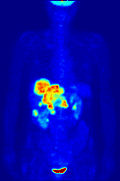Fluorodeoxyglucose (18F)
A radiopharmaceutical used in medical imaging
Fluorodeoxyglucose (18F), commonly abbreviated as FDG, is a radiopharmaceutical used in positron emission tomography (PET) imaging. It is a glucose analog in which the hydroxyl group on the 2' carbon of the glucose molecule is replaced by the radioactive isotope fluorine-18. This modification allows FDG to be used as a tracer in PET scans to assess glucose metabolism in tissues.
Chemical Properties[edit]
FDG is a derivative of glucose, specifically a fluorinated analog. The substitution of the hydroxyl group with fluorine-18 makes it a suitable tracer for imaging because it mimics glucose uptake in cells but is not metabolized in the same way. The chemical formula for FDG is C6H11FO5, and it has a molecular weight of approximately 181.1 g/mol.
Mechanism of Action[edit]
FDG is taken up by cells via glucose transporters, similar to glucose. Once inside the cell, it is phosphorylated by hexokinase to FDG-6-phosphate. However, unlike glucose-6-phosphate, FDG-6-phosphate is not a substrate for further metabolism in the glycolytic pathway. This leads to its accumulation in cells, allowing for imaging of metabolic activity.
Clinical Applications[edit]
FDG is primarily used in PET imaging to evaluate metabolic activity in tissues. It is particularly useful in oncology, neurology, and cardiology.
Oncology[edit]
In oncology, FDG-PET is used to detect and monitor various types of cancer. Tumors often exhibit increased glucose metabolism, leading to higher uptake of FDG. This property allows for the detection of primary tumors, metastases, and the assessment of treatment response.
Neurology[edit]
In neurology, FDG-PET is used to study brain metabolism. It is valuable in the diagnosis and management of epilepsy, Alzheimer's disease, and other neurodegenerative disorders. Areas of altered glucose metabolism can indicate regions of the brain affected by disease.
Cardiology[edit]
In cardiology, FDG-PET helps assess myocardial viability. It can differentiate between viable and non-viable myocardial tissue in patients with ischemic heart disease.
Production[edit]
FDG is produced in a cyclotron where fluorine-18 is generated by bombarding oxygen-18 enriched water with protons. The fluorine-18 is then chemically incorporated into a glucose analog through a series of synthesis steps. Due to the short half-life of fluorine-18 (approximately 110 minutes), FDG must be produced and used quickly.
Safety and Precautions[edit]
FDG is generally safe when used in medical imaging, but as with all radiopharmaceuticals, it involves exposure to radiation. The amount of radiation is relatively low and is considered safe for diagnostic purposes. However, precautions are taken to minimize exposure to patients and healthcare workers.
Related pages[edit]
-
Fluorodeoxyglucose (18F)
-
Synthesis of 18FDG
-
PET MIPS Animation
Ad. Transform your life with W8MD's Budget GLP-1 injections from $75


W8MD offers a medical weight loss program to lose weight in Philadelphia. Our physician-supervised medical weight loss provides:
- Weight loss injections in NYC (generic and brand names):
- Zepbound / Mounjaro, Wegovy / Ozempic, Saxenda
- Most insurances accepted or discounted self-pay rates. We will obtain insurance prior authorizations if needed.
- Generic GLP1 weight loss injections from $75 for the starting dose.
- Also offer prescription weight loss medications including Phentermine, Qsymia, Diethylpropion, Contrave etc.
NYC weight loss doctor appointmentsNYC weight loss doctor appointments
Start your NYC weight loss journey today at our NYC medical weight loss and Philadelphia medical weight loss clinics.
- Call 718-946-5500 to lose weight in NYC or for medical weight loss in Philadelphia 215-676-2334.
- Tags:NYC medical weight loss, Philadelphia lose weight Zepbound NYC, Budget GLP1 weight loss injections, Wegovy Philadelphia, Wegovy NYC, Philadelphia medical weight loss, Brookly weight loss and Wegovy NYC
|
WikiMD's Wellness Encyclopedia |
| Let Food Be Thy Medicine Medicine Thy Food - Hippocrates |
Medical Disclaimer: WikiMD is not a substitute for professional medical advice. The information on WikiMD is provided as an information resource only, may be incorrect, outdated or misleading, and is not to be used or relied on for any diagnostic or treatment purposes. Please consult your health care provider before making any healthcare decisions or for guidance about a specific medical condition. WikiMD expressly disclaims responsibility, and shall have no liability, for any damages, loss, injury, or liability whatsoever suffered as a result of your reliance on the information contained in this site. By visiting this site you agree to the foregoing terms and conditions, which may from time to time be changed or supplemented by WikiMD. If you do not agree to the foregoing terms and conditions, you should not enter or use this site. See full disclaimer.
Credits:Most images are courtesy of Wikimedia commons, and templates, categories Wikipedia, licensed under CC BY SA or similar.
Translate this page: - East Asian
中文,
日本,
한국어,
South Asian
हिन्दी,
தமிழ்,
తెలుగు,
Urdu,
ಕನ್ನಡ,
Southeast Asian
Indonesian,
Vietnamese,
Thai,
မြန်မာဘာသာ,
বাংলা
European
español,
Deutsch,
français,
Greek,
português do Brasil,
polski,
română,
русский,
Nederlands,
norsk,
svenska,
suomi,
Italian
Middle Eastern & African
عربى,
Turkish,
Persian,
Hebrew,
Afrikaans,
isiZulu,
Kiswahili,
Other
Bulgarian,
Hungarian,
Czech,
Swedish,
മലയാളം,
मराठी,
ਪੰਜਾਬੀ,
ગુજરાતી,
Portuguese,
Ukrainian


